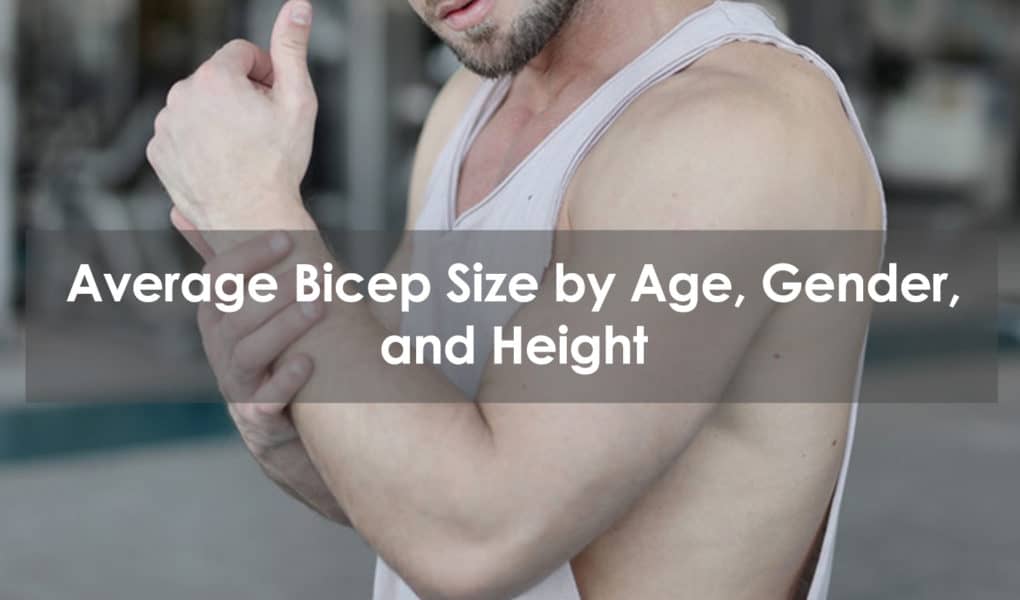Your biceps may not be the biggest muscle in your upper body – in fact, they’re not even the largest arm muscles – but they are prominent when it comes to aesthetics and many people choose to focus on building stronger biceps.
Average bicep size differs according to a variety of factors, which include your age, gender, and BMI (Body Mass Index). Here, we will look at the average bicep size for different demographics, what influences this average size, and how you can build bigger bicep muscles.
Average bicep size by age and gender
Age is one of the biggest influences on your bicep muscles and their relative strength and size. As a child and adolescent, these muscles are still developing and so the average size is smaller, whereas throughout adulthood they will hit their peak size and then gradually get smaller as you grow older.
It’s also important to remember that your gender will impact your bicep measurements; on average, females have smaller biceps than males. So, we’re going to look at the average biceps size for either gender dependant on age.
Bicep Sizes for Females
| Age | Average biceps size in inches |
| 20–29 | 12.4 |
| 30–39 | 12.9 |
| 40–49 | 12.9 |
| 50–59 | 12.9 |
| 60–69 | 12.7 |
| 70–79 | 12.6 |
| 80+ | 11.4 |
Bicep Sizes for Males
| Age | Average biceps size in inches |
| 20–29 | 13.3 |
| 30–39 | 13.8 |
| 40–49 | 13.9 |
| 50–59 | 13.5 |
| 60–69 | 13.4 |
| 70–79 | 12.9 |
| 80+ | 12.1 |
Average biceps size by height
There is very little research into the correlation between bicep size and height because what evidence there already is strongly suggests that height does not have much of an impact on average biceps size, regardless of the demographic.
A more important factor that affects your bicep size is BMI, which is a measurement of your body fat based on your weight and height. This is not a definitive measurement, but generally, those with a higher BMI will have larger biceps.
Of course, this doesn’t necessarily mean the biceps muscle itself is larger, as it can be body fat in that area that makes the measurement larger. In fact, BMI is not considered an accurate indicator of strength. The average bicep sizes listed in the tables above are for people with average body sizes.
How to build bigger biceps
There are two key factors to consider when making your biceps stronger; exercise and diet. First, you will need to undertake resistance training that activates your biceps brachii (the technical term for your biceps muscle).
You should try to develop a planned biceps routine so that you are working the muscles at least twice a week, with sufficient rest periods in between each workout. When you lift weights, you cause microscopic tears in the muscle, which your body then heals during recovery, and this is when the muscle increases in size.
The bicep curl is likely the first exercise your mind goes to when thinking about what to include in your biceps routine, though you shouldn’t just rely on that one isolation exercise.
Bicep workouts should also include compound movements – which work numerous joints and muscle groups at once – such as bent-over rows and pull-ups. The biceps muscle on either arm is still fully engaged with these exercises, but with the support of other muscles, you’re able to lift heavier weight.
Your primary focus should be maintaining proper form when executing any exercise. At first, start out with a lighter weight so you can perfect your form and get a better idea of what your base level of strength is. From there, you can gradually increase the amount of weight you lift, the reps you perform, or the frequency of your training – this is known as progressive overload.
When it comes to your diet, if you’re looking to increase your muscle mass then you will need to be consuming more calories than you are burning each day. There are numerous ways you can work out these figures and once you do, you should aim to consume roughly 300 calories more than you’re expending each day.
Protein intake is vital to building strength and size, and you should aim to consume 15 to 25 grams of protein with each meal. You should also maintain a healthy diet with sufficient levels of fat and carbohydrates to ensure your body functions properly.
How to measure biceps size
So, now that you’ve got a better idea of what average biceps are for certain age groups and genders, it’s time to learn how to properly measure your own biceps to see how you stack up.
There are two ways you can do this; with flexed biceps, or relaxed biceps. The choice is yours and there isn’t much of a consensus on which is better, so long as you stick to the same method every time if you plan on comparing your biceps size over time.
How to measure relaxed biceps
- Stand straight with your arms relaxed by your sides.
- Wrap a soft measuring tape around the midpoint between your shoulder and elbow, then take note of the measurement.
How to measure flexed biceps
- Sit at a table and place your elbow on it. Make a fist and curl your arm up toward your shoulder, as if you were performing a bicep curl.
- Tense your bicep as much as you can, then wrap a measuring tape around it at the midpoint between your shoulder and elbow.
Final Thoughts
There are several factors that contribute to biceps size, some of which are out of your control – gender and age, for example.
However, there are ways you can increase the size of your biceps if that is a goal of yours; through regular resistance training and a balanced diet with plenty of protein.
Frequently Asked Questions
Is 17-inch biceps good?
This depends on a few factors, most importantly your age, gender, and BMI. As shown above, the average size of a woman’s bicep is around the 12-inch mark and for men, it is roughly 13 inches. So, 17-inch biceps would be way above average regardless of your age or gender.
However, if you have a high BMI then there is a good chance the size of your biceps is more down to body fat, rather than lean muscle tissue, which is not considered healthy.







